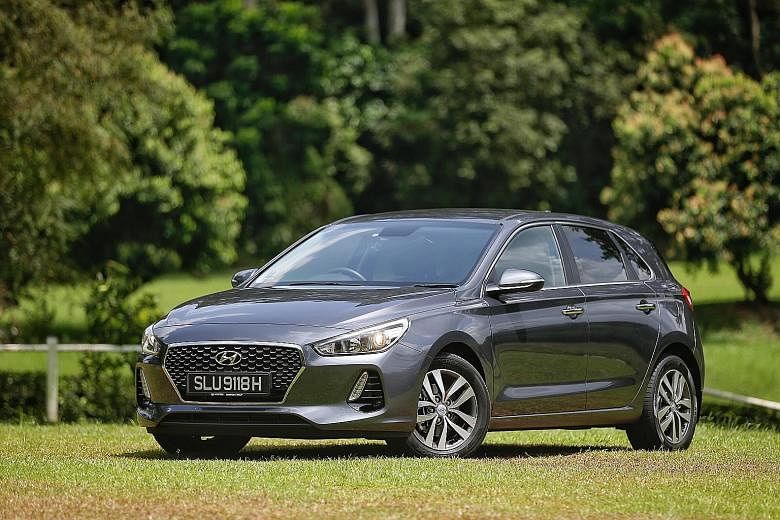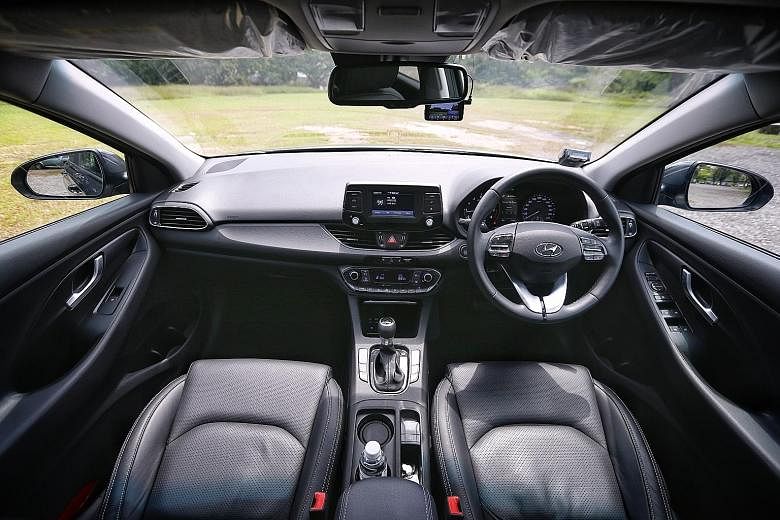The Hyundai i30 hatchback may share its platform with the Kona crossover, but the two are quite different creatures.
The i30 immediately comes across as a more refined machine, with better insulation against harshness and vibration than the Kona.
While both have direct-injection turbocharged engines, the i30's power plant has a smaller displacement of 1.4 litres instead of the Kona's 1.6.
The European-made i30 is also a bigger vehicle, with a larger footprint than Volkswagen's benchmark Golf. As such, it is not as nippy as the Kona, but is still adequate for Singapore roads.
Once it overcomes inertia and is cruising above 60kmh, it becomes fairly lively. Mid-stream acceleration is better than average and the engine displays noticeably more stamina and flexibility than the Kona's, pulling uncomplainingly from 2,500rpm to 5,000rpm.
So, while the i30 trails behind the Kona in a sprint, the hatch catches up eventually. Both cars are fitted with a seven-speed dual-clutch gearbox and both peak at 205kmh.
The i30 is a more efficient car, averaging seven litres per 100km, versus 10 litres for the punchier but thirstier Kona.
-
SPECS / HYUNDAI i30 1.4 TURBO
-
Price: $91,999 with COE
-
Engine: 1,353cc 16-valve inline-4 turbocharged
-
Transmission: Seven-speed dual-clutch with manual override
-
Power: 138bhp at 6,000rpm
-
Torque: 242Nm at 1,500-4,500rpm
-
0-100kmh: 9.2 seconds
-
Top speed: 205kmh
-
Fuel consumption: 5.5 litres/100km
-
Agent: Komoco
But unlike the Kona, the i30 revels in being driven hard. Drop the gears, plant your foot down and you will hear a low sporty rumble as the tachometer climbs and the car hurtles ahead. It does so without a fuss and without any unwanted vibration intruding the cabin.
Aurally, the engine has an "unburstable" quality which belies its size. Quite impressive, really.
Overall, the car feels reassuringly solid, rivaling the standard-bearing Volkswagen Golf in the way occupants are shielded from what goes on outside the passenger cell.
The ride quality is slightly better than the Kona's and the handling significantly sharper. At the wheel, the car feels confident and planted, with an unwavering chassis which requires little steering intervention but responds readily to the slightest input.
Now, the similarities: Like the Kona, the i30 is a stylish car. It sports a more self-assured design, with much tighter contours than its predecessor. Its radiator grille, however, is clearly inspired by Audi's, with a "cascading" mesh first used by Mercedes-Benz.
Inside, the i30 shares the same multi-function steering wheel as the Kona. The rest of its cockpit is unique though, with a better touch and feel.
The car has electric parking brake with auto hold and release, but manual seat adjustments.
Like the Kona, it offers wireless phone charging and an infotainment system with Bluetooth connectivity.
There is more room all round for occupants and cargo. Seats in the second row are also cushier, with better thigh support.
And its doors close with a more reassuring thud and their hinges are smoother, allowing for more fluid opening and closing.
Lastly, the car fills a 1.4-litre void left by Volkswagen. And going by how it drives and feels on the inside, it is more than capable of filling that void. Its competitive pricing is icing on the cake.


